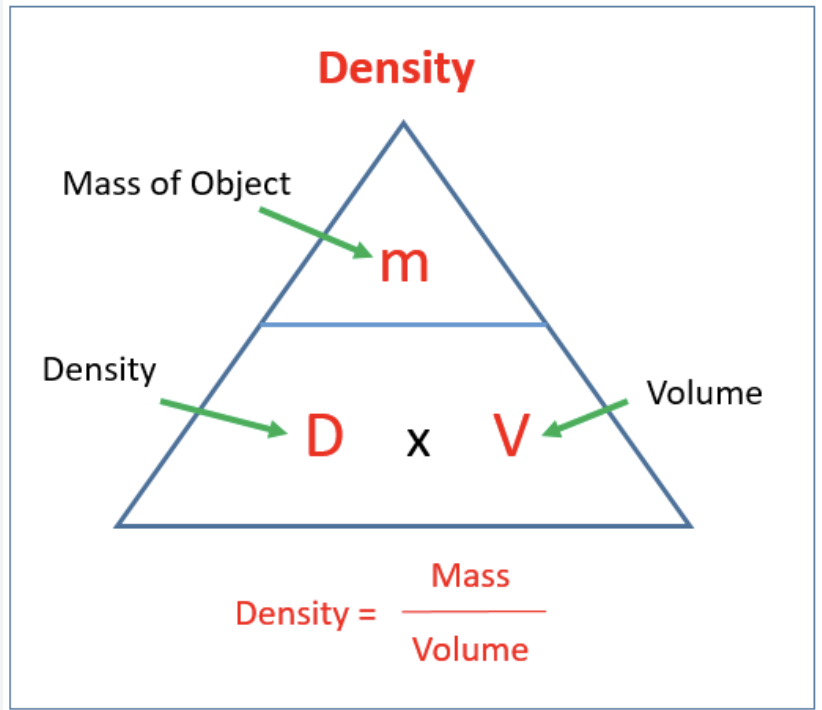CHEMISTRY - MASS, VOLUME, DENSITY
1/34
There's no tags or description
Looks like no tags are added yet.
Name | Mastery | Learn | Test | Matching | Spaced |
|---|
No study sessions yet.
35 Terms
WHAT IS WEIGHT?
Measurement of the effect gravity has on an object.
Changes on: Moon, space, other planets.
WHAT IS MASS?
Measurement of how much matter an object contains.
WHAT IS VOLUME?
Volume is a measurement of how much space is measured. Volume is amount of space.
WHAT IS DENSITY?
Derired property of matter. How compact matter is in an object. Needs mass / volume.
UNIT FOR MASS, VOLUME, DENSITY
Mass: Grams
Volume: mL or cm3
Density: g/cm3 or g/mL
HOW ARE MASS AND WEIGHT DIFFERENT?
Mass is amount of matter.
Weight depends on gravity.
INSTRUMENT USED TO MEASURE MASS AND VOLUME.
Mass: Triple beam balance and electric/digital scale.
Volume: Graduated cylinder NOT BEAKER.
How to use triple beam balance
Move weight to zero.
Calibrate.
Place object.
Move weights.
WATER DISPLACEMENT USING GRADUATED CYLINDER.
Pour initial amount of water.
Place object into cylinder.
(If floats, push it down with a pencil.)
Record final amount.
final - initial = actual
TARE METHOD
Set to grams 000g
Place empty container to T (tare)
Pour liquid while still on scale
Weight of empty container subtracts on its own to get mass of object.
FORMULA FOR DENSITY
D = g/mL or D= g/cm3
HOW TO GET DENSITY
Divide mass from volume for answer.

MATTER
Almost everything, anything that takes up space. Anything that has mass.
Ex: Chair, pencil, house, TV, etc.
Aren’t matter ex: Light, shadow, sound, color, energy, electricity, etc.
WHAT ARE MEASUREMENTS WE TAKE OF MATTER? WHAT ARE THE PROPERTIES OF MATTER?
Mass, Volume, Density.
TIME:
Measured in hours, mins, secs.
WHAT MAKES UP THE MEATRIC SYSTEM?
Mass, Volume, Density, Length
MEATRIC SYSTEM IS MEASURED IN:
Neutons
1cm x 1cm x 1cm =
CM3 which can only be geometric shape to be measured for volume.
LX W X H
LIQUID VOLUME IS MEASURED IN:
Measured in leters
1 CM3 =
1 MILILETER or mL
mL: cm3:
mL: liquids/ irregular solids cm3: solids ex: cube
FLOAT:
All have a higher volume then mass.
SINK:
All have a higher mass than volume.
Does mass alone determine whether an object will float or sink?
No, you need mass and also volume to determine the density to see if an object floats
What do you notice about the density of the floating objects?
I notice the density of the floating objects are lower than 1.
What do you notice about the density of the sinking objects?
I notice the density of the sinking objects are higher than 1.
Buoyancy
is the tendency to float
How do you think the liquid density affects the buoyancy of objects placed in the liquid?
yes bc it is changing the objects tendency to float.
When liquid density goes higher, the buoyancy goes down.
When density goes lower, the buoyancy goes up.
What is the relationship between the object density, the liquid density, and the tendency of the object to float?
the greater the difference between the object's density and the liquid's density, the more likely the object is to float
DOES DENSITY CHANGE WHEN CUT IN HALF AND WHY?
No
When you cut an object in half, both its mass and volume are halved, which means the ratio (density) stays the same.
MENISCUS:
Curved surface of liquid.
Read meniscus volume from bottom to get an accurate measurement.
1g/cm is density of:
pure water density.
Steps to solve word problem:
write down formula
Insert numbers/units
Answer with units
How to get mass?
Density x volume
How to get volume?
Mass / density